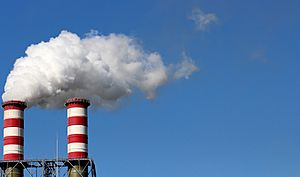Externality facts for kids
In economics, some decisions affect third parties. These parties can be affected by the decision positively or negatively, but this influence is involuntary. This is known as an externality, or an external effect. The problem with externalities is that no one pays for the cost of these effects. Usually, they are not part of the decision process. Externalities are often a form of market failure. In many cases, actors like states need to become active.
An example of an externality is pollution. One way to solve this is to introduce taxes on the goods that cause the pollution, for example carbon dioxide, which is the one of the causes of global warming. With concepts such as emissions trading, these externalities can again become part of the market system (and are no longer external).
Images for kids
-
Air pollution from motor vehicles is an example of a negative externality. The costs of the air pollution for the rest of society is not compensated for by either the producers or users of motorized transport.
-
Light pollution is an example of an externality because the consumption of street lighting has an effect on bystanders that is not compensated for by the consumers of the lighting.
See also
 In Spanish: Externalidad para niños
In Spanish: Externalidad para niños









